The French Revolution began on July 14, 1789 when a crowd of Parisians stormed the Bastille prison, a symbol of the despotic power of the French king. They were alarmed by rumors that the king had ordered troops into the city to open fire on citizens. Seeking weapons to defend themselves, the crowd broke into government buildings and marched to the Bastille, where a fight broke out. The commander of the Bastille was killed during the fight, the few prisoners held there were released, and the fortress was demolished. This event marked the beginning of the French Revolution and the overthrow of the absolute monarchy in France.
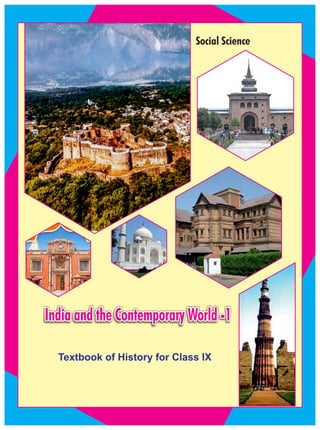










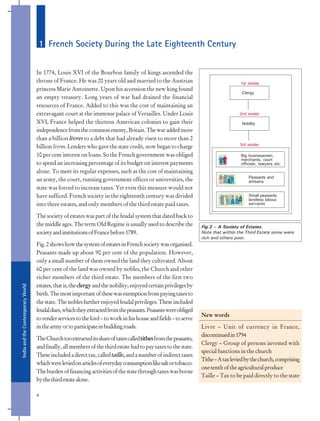


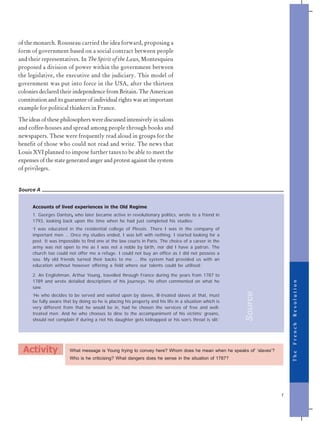
























![India
and
the
Contemporary
World
32
Source A
deeply religious. But except in a few cases they had no respect for the
nobility. Nobles got their power and position through their services
to the Tsar, not through local popularity. This was unlike France
where, during the French Revolution in Brittany, peasants respected
nobles and fought for them. In Russia, peasants wanted the land of
the nobles to be given to them. Frequently, they refused to pay rent
and even murdered landlords. In 1902, this occurred on a large scale
in south Russia. And in 1905, such incidents took place all
over Russia.
Russian peasants were different from other European peasants in
another way. They pooled their land together periodically and their
commune(mir)divideditaccordingtotheneedsofindividualfamilies.
2.3 Socialism in Russia
All political parties were illegal in Russia before 1914. The Russian
Social Democratic Workers Party was founded in 1898 by socialists
who respected Marx’s ideas. However, because of government
policing, it had to operate as an illegal organisation. It set up a
newspaper, mobilised workers and organised strikes.
SomeRussiansocialistsfeltthattheRussianpeasantcustomofdividing
land periodically made them natural socialists. So peasants, not
workers, would be the main force of the revolution, and Russia could
become socialist more quickly than other countries. Socialists were
active in the countryside through the late nineteenth century. They
formedtheSocialistRevolutionaryPartyin1900.Thispartystruggled
for peasants’ rights and demanded that land belonging to nobles be
transferred to peasants. Social Democrats disagreed with Socialist
Revolutionaries about peasants. Lenin felt that peasants were not
one united group. Some were poor and others rich, some worked as
labourerswhileotherswerecapitalistswhoemployedworkers.Given
this ‘differentiation’ within them, they could not all be part of a
socialist movement.
The party was divided over the strategy of organisation. Vladimir
Lenin (who led the Bolshevik group) thought that in a repressive
society like Tsarist Russia the party should be disciplined and should
control the number and quality of its members. Others (Mensheviks)
thought that the party should be open to all (as in Germany).
2.4 A Turbulent Time: The 1905 Revolution
Russia was an autocracy. Unlike other European rulers, even at the
beginning of the twentieth century, the Tsar was not subject to
Alexander Shlyapnikov, a socialist
worker of the time, gives us a description
of how the meetings were organised:
‘Propaganda was done in the plants and
shops on an individual basis. There were
also discussion circles … Legal meetings
took place on matters concerning [official
issues], but this activity was skilfully
integrated into the general struggle for
the liberation of the working class. Illegal
meetings were … arranged on the spur
of the moment but in an organised way
during lunch, in evening break, in front
of the exit, in the yard or, in
establishments with several floors, on
the stairs. The most alert workers would
form a “plug” in the doorway, and the
whole mass piled up in the exit. An
agitator would get up right there on the
spot. Management would contact the
police on the telephone, but the
speeches would have already been
made and the necessary decision taken
by the time they arrived ...’
Alexander Shlyapnikov, On the Eve of
1917. Reminiscences from the
Revolutionary Underground.](https://image.slidesharecdn.com/9thhistory-221213143915-85d661e6/85/9TH-HISTORY-pdf-40-320.jpg)
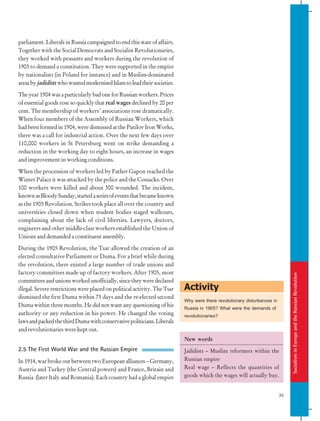






![India
and
the
Contemporary
World
40
Box 3
Activity
The October Revolution and the Russian Countryside: Two Views
‘News of the revolutionary uprising of October 25, 1917, reached the village the following day and
was greeted with enthusiasm; to the peasants it meant free land and an end to the war. ...The day
the news arrived, the landowner’s manor house was looted, his stock farms were “requisitioned”
and his vast orchard was cut down and sold to the peasants for wood; all his far buildings were
torn down and left in ruins while the land was distributed among the peasants who were prepared
to live the new Soviet life’.
From: Fedor Belov, The History of a Soviet Collective Farm
A member of a landowning family wrote to a relative about what happened at the estate:
‘The “coup” happened quite painlessly, quietly and peacefully. …The first days were unbearable..
Mikhail Mikhailovich [the estate owner] was calm...The girls also…I must say the chairman
behaves correctly and even politely. We were left two cows and two horses. The servants tell them
all the time not to bother us. “Let them live. We vouch for their safety and property. We want them
treated as humanely as possible….”
…There are rumours that several villages are trying to evict the committees and return the estate
to Mikhail Mikhailovich. I don’t know if this will happen, or if it’s good for us. But we rejoice that
there is a conscience in our people...’
From: Serge Schmemann, Echoes of a Native Land. Two Centuries of a Russian Village (1997).
4.1 The Civil War
When the Bolsheviks ordered land redistribution, the Russian army
began to break up. Soldiers, mostly peasants, wished to go home for
the redistribution and deserted. Non-Bolshevik socialists, liberals and
supporters of autocracy condemned the Bolshevik uprising. Their
leaders moved to south Russia and organised troops to fight the
Bolsheviks (the ‘reds’). During 1918 and 1919, the ‘greens’ (Socialist
Revolutionaries) and ‘whites’ (pro-Tsarists) controlled most of the
Russian empire. They were backed by French, American, British
andJapanesetroops–allthoseforceswhowereworriedatthegrowth
of socialism in Russia. As these troops and the Bolsheviks fought a
civil war, looting, banditry and famine became common.
Supporters of private property among ‘whites’ took harsh steps with
peasants who had seized land. Such actions led to the loss of popular
support for the non-Bolsheviks. By January 1920, the Bolsheviks
controlled most of the former Russian empire. They succeeded due
Read the two views on the revolution in the
countryside. Imagine yourself to be a witness
to the events. Write a short account from the
standpoint of:
an owner of an estate
a small peasant
a journalist](https://image.slidesharecdn.com/9thhistory-221213143915-85d661e6/85/9TH-HISTORY-pdf-48-320.jpg)
![Socialism
in
Europe
and
the
Russian
Revolution
41
Activity
Source B
to cooperation with non-Russian nationalities and Muslim jadidists.
CooperationdidnotworkwhereRussiancoloniststhemselvesturned
Bolshevik. In Khiva, in Central Asia, Bolshevik colonists brutally
massacred local nationalists in the name of defending socialism. In
this situation, many were confused about what the Bolshevik
government represented.
Partly to remedy this, most non-Russian nationalities were given
political autonomy in the Soviet Union (USSR) – the state the
Bolsheviks created from the Russian empire in December 1922. But
since this was combined with unpopular policies that the Bolsheviks
forcedthelocalgovernmenttofollow–liketheharshdiscouragement
of nomadism – attempts to win over different nationalities were
only partly successful.
Central Asia of the October Revolution: Two Views
M.N.Roy was an Indian revolutionary, a founder of the Mexican Communist Party
and prominent Comintern leader in India, China and Europe. He was in Central
Asia at the time of the civil war in the 1920s. He wrote:
‘The chieftain was a benevolent old man; his attendant … a youth who … spoke
Russian … He had heard of the Revolution, which had overthrown the Tsar and
driven away the Generals who conquered the homeland of the Kirgiz. So, the
Revolution meant that the Kirgiz were masters of their home again. “Long Live the
Revolution” shouted the Kirgiz youth who seemed to be a born Bolshevik. The
whole tribe joined.’
M.N.Roy, Memoirs (1964).
‘The Kirghiz welcomed the first revolution (ie February Revolution) with joy and the
second revolution with consternation and terror … [This] first revolution freed them
from the oppression of the Tsarist regime and strengthened their hope that …
autonomy would be realised. The second revolution (October Revolution) was
accompanied by violence, pillage, taxes and the establishment of dictatorial power
… Once a small group of Tsarist bureaucrats oppressed the Kirghiz. Now the same
group of people … perpetuate the same regime ...’
Kazakh leader in 1919, quoted in Alexander Bennigsen and Chantal Quelquejay,
Les Mouvements Nationaux chez les Musulmans de Russie, (1960).
Why did people in Central Asia respond to the Russian Revolution in
different ways?
New words
Autonomy – The right to govern
themselves
Nomadism – Lifestyle of those who do
not live in one place but move from area
to area to earn their living
Source](https://image.slidesharecdn.com/9thhistory-221213143915-85d661e6/85/9TH-HISTORY-pdf-49-320.jpg)
![India
and
the
Contemporary
World
42
Box 4
Socialist Cultivation in a Village in the Ukraine
‘A commune was set up using two [confiscated] farms as a base. The commune
consisted of thirteen families with a total of seventy persons … The farm tools taken
from the … farms were turned over to the commune …The members ate in a communal
dining hall and income was divided in accordance with the principles of “cooperative
communism”. The entire proceeds of the members’ labor, as well as all dwellings and
facilities belonging to the commune were shared by the commune members.’
Fedor Belov, The History of a Soviet Collective Farm (1955).
Fig.14 – Factories came to be seen as a
symbol of socialism.
This poster states: ‘The smoke from the
chimneys is the breathing of Soviet Russia.’
4.2 Making a Socialist Society
During the civil war, the Bolsheviks kept industries and banks
nationalised. They permitted peasants to cultivate the land that had
beensocialised.Bolsheviksusedconfiscatedlandtodemonstratewhat
collective work could be.
A process of centralised planning was introduced. Officials assessed
how the economy could work and set targets for a five-year period.
On this basis they made the Five Year Plans. The government fixed
all prices to promote industrial growth during the first two ‘Plans’
(1927-1932 and 1933-1938). Centralised planning led to economic
growth. Industrial production increased (between 1929 and 1933 by
100 per cent in the case of oil, coal and steel). New factory cities
came into being.
However, rapid construction led to poor working conditions. In
thecityofMagnitogorsk,theconstructionofasteelplantwasachieved
in three years. Workers lived hard lives and the result was 550
stoppages of work in the first year alone. In living quarters, ‘in the
wintertime, at 40 degrees below, people had to climb down from the
fourth floor and dash across the street in order to go to the toilet’.
An extended schooling system developed, and arrangements were
made for factory workers and peasants to enter universities. Crèches
were established in factories for the children of women workers.
Cheap public health care was provided. Model living quarters were
set up for workers. The effect of all this was uneven, though, since
government resources were limited.](https://image.slidesharecdn.com/9thhistory-221213143915-85d661e6/85/9TH-HISTORY-pdf-50-320.jpg)




![Socialism
in
Europe
and
the
Russian
Revolution
47
Source G
Source F
An Indian arrives in Soviet Russia in 1920
‘For the first time in our lives, we were seeing Europeans
mixing freely with Asians. On seeing the Russians mingling
freely with the rest of the people of the country we were
convinced that we had come to a land of real equality.
We saw freedom in its true light. In spite of their poverty,
imposed by the counter-revolutionaries and the imperialists,
the people were more jovial and satisfied than ever before.
The revolution had instilled confidence and fearlessness in
them. The real brotherhood of mankind would be seen here
among these people of fifty different nationalities. No
barriers of caste or religion hindered them from mixing freely
with one another. Every soul was transformed into an orator.
One could see a worker, a peasant or a soldier haranguing
like a professional lecturer.’
Shaukat Usmani, Historic Trips of a Revolutionary.
Rabindranath Tagore wrote from Russia in 1930
‘Moscow appears much less clean than the other
European capitals. None of those hurrying along the
streets look smart. The whole place belongs to the
workers … Here the masses have not in the least been
put in the shade by the gentlemen … those who lived in
the background for ages have come forward in the open
today … I thought of the peasants and workers in my
own country. It all seemed like the work of the Genii in
the Arabian Nights. [here] only a decade ago they were
as illiterate, helpless and hungry as our own masses …
Who could be more astonished than an unfortunate Indian
like myself to see how they had removed the mountain of
ignorance and helplessness in these few years’.
Activity
Compare the passages written by Shaukat
Usmani and Rabindranath Tagore. Read
them in relation to Sources C, D and E.
What did Indians find impressive about
the USSR ?
What did the writers fail to notice?](https://image.slidesharecdn.com/9thhistory-221213143915-85d661e6/85/9TH-HISTORY-pdf-55-320.jpg)








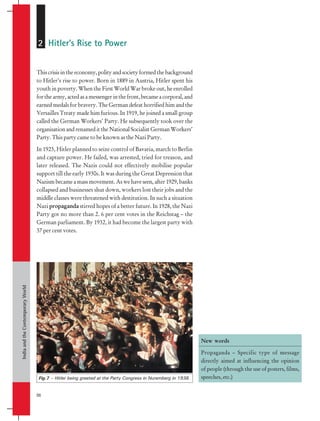
















































![Pastoralists
in
the
Modern
World
105
Activity
Source D
specified, and the number of days they could spend in the forest
was limited. Pastoralists could no longer remain in an area even if
forage was available, the grass was succulent and the undergrowth
in the forest was ample. They had to move because the Forest
Department permits that had been issued to them now ruled their
lives. The permit specified the periods in which they could be
legally within a forest. If they overstayed they were liable to fines.
Third, British officials were suspicious of nomadic people. They
distrusted mobile craftsmen and traders who hawked their goods
in villages, and pastoralists who changed their places of residence
every season, moving in search of good pastures for their herds.
The colonial government wanted to rule over a settled population.
They wanted the rural people to live in villages, in fixed places
with fixed rights on particular fields. Such a population was easy
to identify and control. Those who were settled were seen as
peaceable and law abiding; those who were nomadic were
considered to be criminal. In 1871, the colonial government in
India passed the Criminal Tribes Act. By this Act many
communities of craftsmen, traders and pastoralists were classified
as Criminal Tribes. They were stated to be criminal by nature
and birth. Once this Act came into force, these communities were
expected to live only in notified village settlements. They were
not allowed to move out without a permit. The village police
kept a continuous watch on them.
Fourth, to expand its revenue income, the colonial government
looked for every possible source of taxation. So tax was imposed
on land, on canal water, on salt, on trade goods, and even on
animals. Pastoralists had to pay tax on every animal they grazed
on the pastures. In most pastoral tracts of India, grazing tax was
introduced in the mid-nineteenth century. The tax per head of
cattle went up rapidly and the system of collection was made
increasingly efficient. In the decades between the 1850s and 1880s
the right to collect the tax was auctioned out to contractors. These
contractors tried to extract as high a tax as they could to recover
the money they had paid to the state and earn as much profit as
they could within the year. By the 1880s the government began
collecting taxes directly from the pastoralists. Each of them was
given a pass. To enter a grazing tract, a cattle herder had to show
the pass and pay the tax. The number of cattle heads he had and
the amount of tax he paid was entered on the pass.
In the 1920s, a Royal Commission on
Agriculture reported:
‘The extent of the area available for
grazing has gone down tremendously
with the extension of area under
cultivation because of increasing
population, extension of irrigation
facilities, acquiring the pastures for
Government purposes, for example,
defence, industries and agricultural
experimental farms. [Now] breeders find
it difficult to raise large herds. Thus their
earnings have gone down. The quality
of their livestock has deteriorated,
dietary standards have fallen and
indebtedness has increased.’
The Report of the Royal Commission of
Agriculture in India, 1928.
Imagine you are living in the 1890s.
You belong to a community of nomadic
pastoralists and craftsmen. You learn that the
Government has declared your community as
a Criminal Tribe.
Describe briefly what you would have
felt and done.
Write a petition to the local collector
explaining why the Act is unjust and
how it will affect your life.](https://image.slidesharecdn.com/9thhistory-221213143915-85d661e6/85/9TH-HISTORY-pdf-113-320.jpg)



















